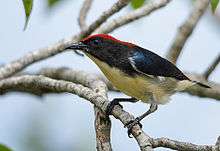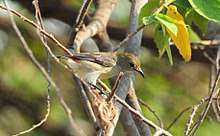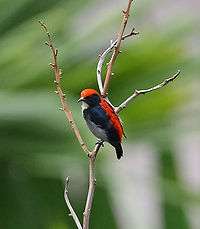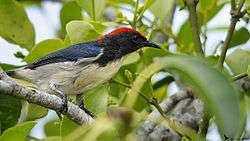Scarlet-backed flowerpecker
The scarlet-backed flowerpecker (Dicaeum cruentatum) is a species of passerine bird in the flowerpecker family Dicaeidae. Sexually dimorphic, the male has navy blue upperparts with a bright red streak down its back from its crown to its tail coverts, while the female and juvenile are predominantly olive green. It is found in subtropical or tropical moist lowland forests and occasionally gardens in a number of countries throughout South and East Asia.
| Scarlet-backed flowerpecker | |
|---|---|
 | |
| Male | |
| Scientific classification | |
| Kingdom: | Animalia |
| Phylum: | Chordata |
| Class: | Aves |
| Order: | Passeriformes |
| Family: | Dicaeidae |
| Genus: | Dicaeum |
| Species: | D. cruentatum |
| Binomial name | |
| Dicaeum cruentatum | |
| Synonyms | |
| |
Taxonomy
The scarlet-backed flowerpecker was originally described by Carl Linnaeus in his landmark 1758 10th edition of Systema Naturae, with the binomial name Certhia cruentata, among the treecreepers.[2] It was later reclassified into the flowerpecker genus Dicaeum. The specific epithet cruentatum 'bloodstained' is derived from the Latin verb crǔentare 'to stain with blood'.[3] Genetic analysis of mitochondrial DNA of 70% of flowerpecker species showed the scarlet-backed and black-fronted flowerpecker (D. igniferum) - which is endemic to the Indonesian Lesser Sunda Islands - to be each other's closest relative; the males of both species have red plumage on their backs.[4]
Description

Measuring 9 cm (3.5 in) and weighing 7 to 8 grams (0.25 to 0.28 oz), the scarlet-backed flowerpecker is a small bird with a short tail. It exhibits sexual dimorphism. The male has a navy blue face, wings and tail, with a broad bright red stripe from its crown to its upper tail coverts. The female is predominantly olive green with a black tail and scarlet upper tail coverts and rump. Both sexes have creamy white underparts, black eyes and legs, and a dark grey arched bill. The juvenile has plumage similar to the female but has an orange bill and lacks the bright red rump.[5]
Distribution and habitat
It is found in Bangladesh, Bhutan, Brunei, Cambodia, China, India, Indonesia, Laos, Malaysia, Myanmar, Nepal, Singapore, Thailand, and Vietnam. No global population studies have been undertaken; it is thought to be common throughout most of its range particular in Thailand, although it is considered rare in Bhutan and Nepal.[1] It is found up to 1000 m (3500 ft), in subtropical or tropical moist lowland forests, wooded areas and gardens.[5] In the north of its range, it is found in southeastern China to Fujian (as the subspecies Dicaeum c. cruentatum).[5] It has been recorded from both native and plantation forest in West Bengal in India.[6]
Feeding
It has been observed feeding on the figs of Ficus fistulosa and F. grossularoides in Bukit Timah Nature Reserve in Singapore.[7] It visits Syzygium jambos in urban Hong Kong.[8]
Breeding
The scarlet-backed flowerpecker weaves its pouch-shaped nest hanging from a branch high up in a tree. The nest has a side entrance, typical for those of the flowerpecker family.[9]

References

- BirdLife International (2012). "Dicaeum cruentatum". IUCN Red List of Threatened Species. 2012. Retrieved 26 November 2013.CS1 maint: ref=harv (link)
- Linnaeus, Carl (1758). Systema naturae per regna tria naturae, secundum classes, ordines, genera, species, cum characteribus, differentiis, synonymis, locis. Tomus I. Editio decima, reformata (in Latin). Holmiae. (Laurentii Salvii). p. 119.
- Simpson DP (1979). Cassell's Latin Dictionary (5th ed.). London: Cassell Ltd. p. 159. ISBN 0-304-52257-0.
- Nyária, Árpád S.; Peterson, A. Townsend; Rice, Nathan H.; Moyle, Robert G. (2009). "Phylogenetic relationships of flowerpeckers (Aves: Dicaeidae): Novel insights into the evolution of a tropical passerine clade". Molecular Phylogenetics and Evolution. 53 (3): 613–19. doi:10.1016/j.ympev.2009.06.014. hdl:1808/6569. PMID 19576993.
- Brazil, Mark (2009). Birds of East Asia. A&C Black. p. 444. ISBN 978-0-7136-7040-0.
- S. Sivakumar; Jeejo Varghese & Vibhu Prakash (2006). "Abundance of birds in different habitats in Buxa Tiger Reserve, West Bengal, India" (PDF). Forktail. 22: 128–33.
- Peh, Kelvin S.-H.; Chong, Fong Lin (2003). "Seed dispersal agents of two Ficus species in a disturbed tropical forest". Ornithological Science. 2 (2): 119–25. doi:10.2326/osj.2.119.
- Corlett, Richard T. (2005). "Interactions between birds, fruit bats and exotic plants in urban Hong Kong, South China". Urban Ecosystems. 8 (3–4): 275–283. doi:10.1007/s11252-005-3260-x.
- Strange, Morten (2000). Photographic Guide to the Birds of Southeast Asia. Singapore: Periplus. p. 365. ISBN 962-593-403-0.
| Wikimedia Commons has media related to Dicaeum cruentatum. |

